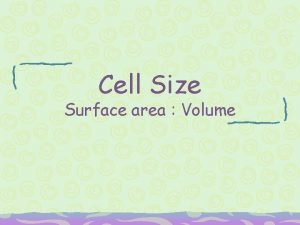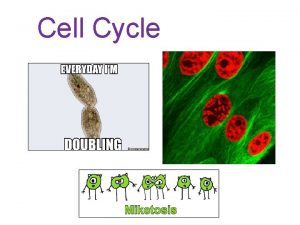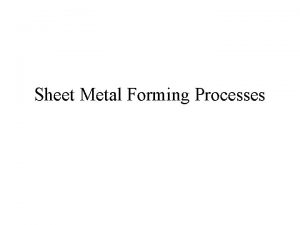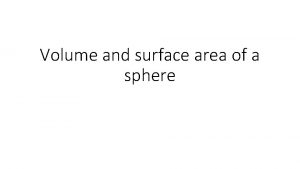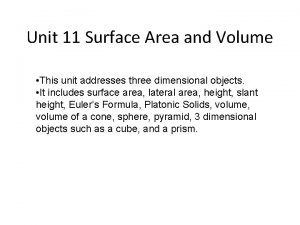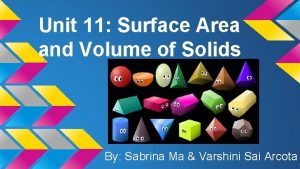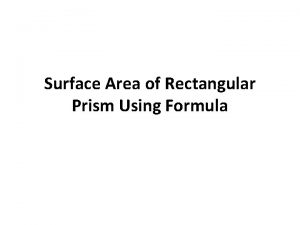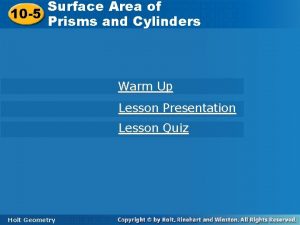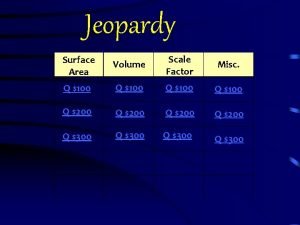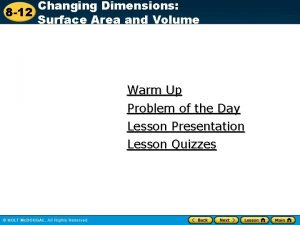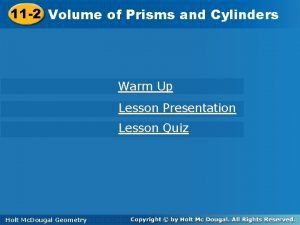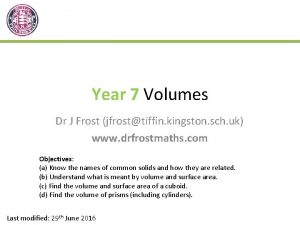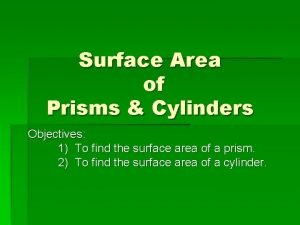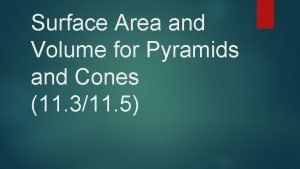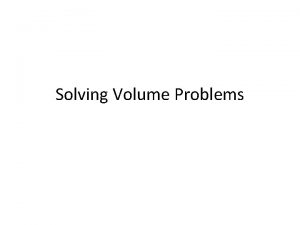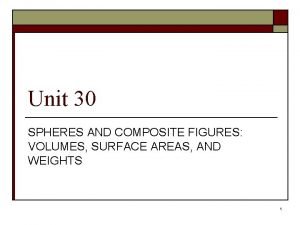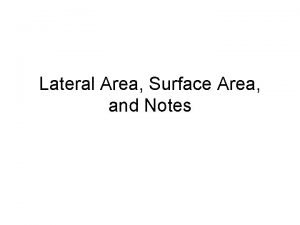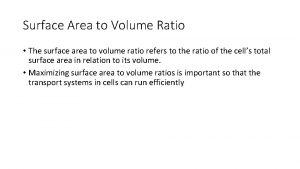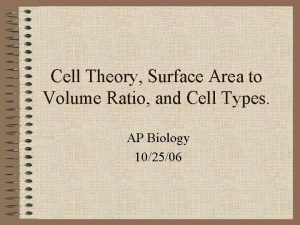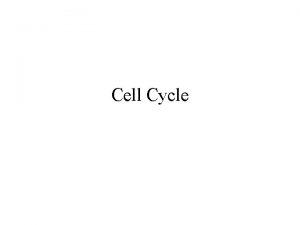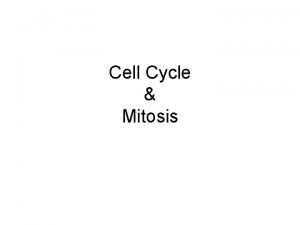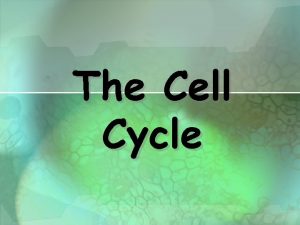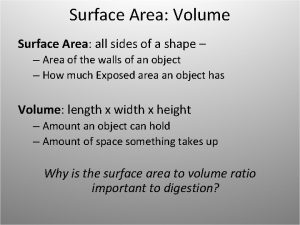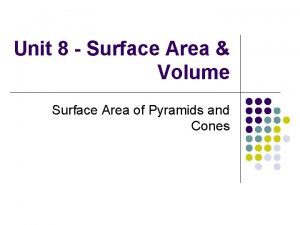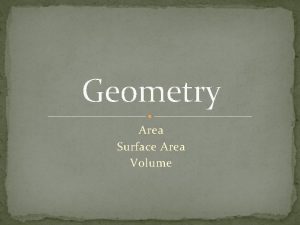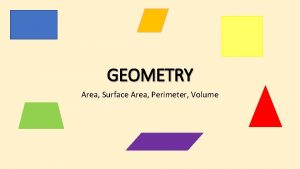Cell Cycle Surface area to volume ratio 6



































- Slides: 35

Cell Cycle

Surface area to volume ratio 6: 1 4: 1 2: 1 -Which SA/V ratio would be more efficient to a cell? A large SA/V ratio…. . 6: 1

Surface area to volume ratio Each time a cell doubles in size, its surface area increases by a factor of four but its volume increases by a factor of eight. It would mean that the cell would need 8 times the normal amount of nutrients and make 8 times the normal amount of wastes.

All cells are relatively the same size. Why? 1. Surface area-to-volume ratio • As a cell grows the volume increases much more rapidly than the surface area – Diffusion is slow – The larger the cell the more food and the more wastes; not efficient.

Cell Size, cont. Increase size of cell Decrease rate of Diffusion Oxygen Nutrients Wastes Water

Cell Size, cont. 2. DNA limits the size of a cell DNA codes for proteins, the larger the cell, the more proteins it needs. The cell can’t make instructions fast enough

DNA makes up the chromosomes inside the nucleus

DNA and Cell Division For the most of a cell’s lifetime, chromosomes exist as chromatin – long strands of DNA wrapped around proteins (called histones).

Under an electron microscope, chromatin looks somewhat chaotic resembling a plate of spaghetti. -This is necessary for the information to be copied.

Chromosome centromere Sister chromatid



White fish blastula Onion root tip

Chromatin vs. Chromosomes Chromatin is loosely coiled DNA Chromosomes are tightly coiled DNA -DNA is tightly coiled around proteins called histones

How does chromatin condense into chromosomes? (Histones Help!)

What is Mitosis? • The cell then enters mitosis. • Division of a cell’s nucleus • Chromosomes (DNA) are equally divided • 2 identical daughter cells that are formed

Mitosis Step 1: Prophase • Nucleus (nuclear membrane) begins to disappear • DNA condenses from chromatin to chromosomes • Centrioles move to opposite sides of the cell • Spindle fibers start to form

Mitosis Step 2: Metaphase • Chromosomes line up along the equator/middle • Each chromosome is connected to a spindle fiber at its centromere • Very short phase

Mitosis Stage 3: Anaphase • Sister chromatids are pulled to opposite poles by centrioles and spindle fibers. Chromosome Sister chromatids

Mitosis Step 4: Telophase • Cell membrane begins to pinch in the middle • New nuclei form around each set of chromosomes • Chromosomes unwind back into chromatin Telophase

Cytokinesis: Division of the cytoplasm • Animal cell • Plant cell • Cell membrane pinches along equator • Forms a cleavage furrow that deepens until the cell is pinched in two • Cell membrane does not pinch in b/c of rigid cell wall • Cell plate forms at the equator that divides the cytoplasm

Cytokinesis -Two new cells




Cytokinesis Cell plate Cleavage furrow

Anaphase

Prophase

Metaphase

Interphase

Cytokinesis

Telophase

Mitosis • In Mitosis, everything is identical. • Takes place in somatic cells (body cells, ex: lung, skin, heart, stomach, etc. )


Results of Mitosis • • Replace old or damaged cells. Occurs fastest in skin cells. Some cells like brain cells do not divide. During early development, mitosis produces the cells needed to make tissues and organs.
 The surface area to volume ratio of a cell limits
The surface area to volume ratio of a cell limits Importance of surface area to volume ratio
Importance of surface area to volume ratio Equator in mitosis
Equator in mitosis Introduction for maths project for class 9
Introduction for maths project for class 9 S=ph lateral surface area
S=ph lateral surface area Curved surface area and total surface area of cone
Curved surface area and total surface area of cone What is the formula for the volume of a hemisphere
What is the formula for the volume of a hemisphere Latwral area
Latwral area Unit 11: volume and surface area
Unit 11: volume and surface area Volume formula rectangle
Volume formula rectangle Volume of prisms and cylinders quiz part 1
Volume of prisms and cylinders quiz part 1 Prism volume and surface area
Prism volume and surface area Flat surface example
Flat surface example Volume and surface area of pyramid
Volume and surface area of pyramid Area of sectors maze geometry
Area of sectors maze geometry Surface area and volume jeopardy
Surface area and volume jeopardy Surface area and volume jeopardy
Surface area and volume jeopardy Volume and surface area jeopardy
Volume and surface area jeopardy Extending surface area and volume
Extending surface area and volume Volume of a cylinder and prism worksheet
Volume of a cylinder and prism worksheet Surface area and volume of cylinders and prisms worksheet
Surface area and volume of cylinders and prisms worksheet Volume cuboid worksheet
Volume cuboid worksheet Effects of changing dimensions on surface area and volume
Effects of changing dimensions on surface area and volume Volume and surface area of rectangular prism
Volume and surface area of rectangular prism Objectives of surface area and volume
Objectives of surface area and volume Surface area and volume of prisms
Surface area and volume of prisms 11-2 volumes of prisms and cylinders
11-2 volumes of prisms and cylinders Dr frost surface area
Dr frost surface area Surface area of a hexagonal prism
Surface area of a hexagonal prism Total surface area of pyramid
Total surface area of pyramid Dr frost probability
Dr frost probability Triangle volume formula
Triangle volume formula Surface area of pyramids and cones answer key
Surface area of pyramids and cones answer key Prism surface area
Prism surface area Determine the volume of the composite figure
Determine the volume of the composite figure What is lateral area
What is lateral area
